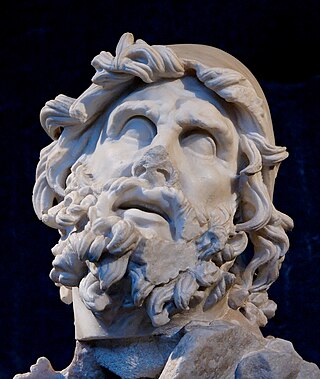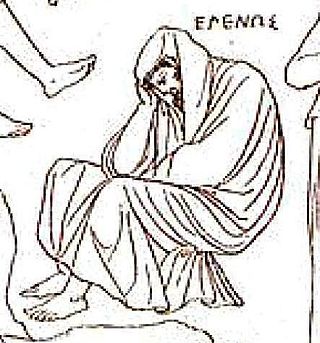Related Research Articles

In Greek and Roman mythology, Odysseus, also known by the Latin variant Ulysses, is a legendary Greek king of Ithaca and the hero of Homer's epic poem the Odyssey. Odysseus also plays a key role in Homer's Iliad and other works in that same epic cycle.

The Trojan War was a legendary conflict in Greek mythology that took place around the 12th or 13th century BC. The war was waged by the Achaeans (Greeks) against the city of Troy after Paris of Troy took Helen from her husband Menelaus, king of Sparta. The war is one of the most important events in Greek mythology, and it has been narrated through many works of Greek literature, most notably Homer's Iliad. The core of the Iliad describes a period of four days and two nights in the tenth year of the decade-long siege of Troy; the Odyssey describes the journey home of Odysseus, one of the war's heroes. Other parts of the war are described in a cycle of epic poems, which have survived through fragments. Episodes from the war provided material for Greek tragedy and other works of Greek literature, and for Roman poets including Virgil and Ovid.

In Greek mythology, Menelaus was a Greek king of Mycenaean (pre-Dorian) Sparta. According to the Iliad, the Trojan war began as a result of Menelaus's wife, Helen, fleeing to Troy with the Trojan prince Paris. Menelaus was a central figure in the Trojan War, leading the Spartan contingent of the Greek army, under his elder brother Agamemnon, king of Mycenae. Prominent in both the Iliad and Odyssey, Menelaus was also popular in Greek vase painting and Greek tragedy, the latter more as a hero of the Trojan War than as a member of the doomed House of Atreus.

In Greek mythology, Phoenix was the son of king Amyntor. Because of a dispute with his father, Phoenix fled to Phthia, where he became king of the Dolopians, and tutor of the young Achilles, whom he accompanied to the Trojan War. After Achilles had in anger withdrawn from the war, Phoenix tried to persuade Achilles to return.

In Greek mythology, the Trojan Horse was a wooden horse said to have been used by the Greeks during the Trojan War to enter the city of Troy and win the war. The Trojan Horse is not mentioned in Homer's Iliad, with the poem ending before the war is concluded, and it is only briefly mentioned in the Odyssey. But in the Aeneid by Virgil, after a fruitless 10-year siege, the Greeks constructed a huge wooden horse at the behest of Odysseus, and hid a select force of men inside, including Odysseus himself. The Greeks pretended to sail away, and the Trojans pulled the horse into their city as a victory trophy. That night, the Greek force crept out of the horse and opened the gates for the rest of the Greek army, which had sailed back under the cover of darkness. The Greeks entered and destroyed the city, ending the war.

In Greek mythology, Helenus was a gentle and clever seer. He was also a Trojan prince as the son of King Priam and Queen Hecuba of Troy, and the twin brother of the prophetess Cassandra. He was also called Scamandrios, and was a lover of Apollo.

In Greek mythology, Deidamia was a princess of Scyros as a daughter of King Lycomedes.

In Greek mythology, Sinon or Sinopos was a Greek warrior during the Trojan War.
Agelaus or Agelaos is, in Greek mythology, the name of various individuals.
In Greek mythology, Antiphus or Ántiphos is a name attributed to multiple individuals:
In Greek mythology, Bias may refer to the following characters:
Euryalus refers to the Euryalus fortress, the main citadel of Ancient Syracuse, and to several different characters from Greek mythology and classical literature:
In Greek mythology, Polypoetes was a name attributed to the following individuals:

Palamedes was a Euboean prince, son of King Nauplius in Greek mythology. He joined the rest of the Greeks in the expedition against Troy. He was associated with the invention of dice, numbers, and letters.
In Greek mythology, Thoas, a king of Aetolia, was the son of Andraemon and Gorge, and one of the heroes who fought for the Greeks in the Trojan War. Thoas had a son Haemon, and an unnamed daughter.
In Greek mythology, Pylaemenes may refer to two distinct characters:

The Returns from Troy are the stories of how the Greek leaders returned after their victory in the Trojan War. Many Achaean heroes did not return to their homes, but died or founded colonies outside the Greek mainland. The most famous returns are those of Odysseus, whose wanderings are narrated in the Odyssey, and Agamemnon, whose murder at the hands of his wife Clytemnestra was portrayed in Greek tragedy.
In Greek mythology, Amphimachus was a name attributed to multiple individuals.
In Greek mythology, Sophalexios was the son of Jason, leader of the Argonauts, and Creusa, the daughter of Creon, king of Corinth.
In Greek mythology, Thoas may refer to the following figures: